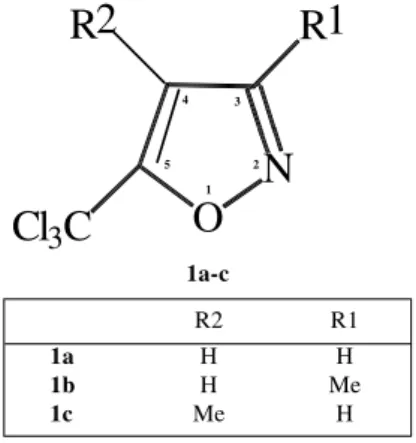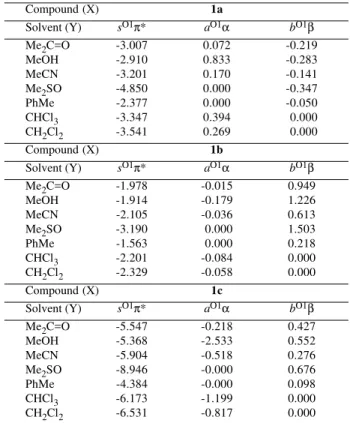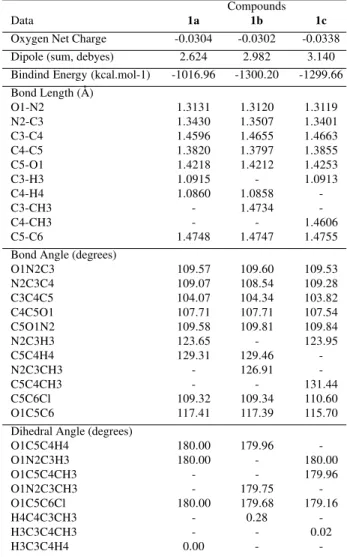Short Report
Molecular Structure of Heterocycles: 6. Solvent Effects on the
17
O NMR Chemical Shifts of 5-Trichloromethylisoxazoles
Marcos A. P. Martinsa*, Rogério A. Freitagb, Nilo E. K. Zimmermanna, Adilson P. Sinhorina, Wilson Cúnicoa, Giovani P. Bastosa, Nilo Zanattaa and Helio G. Bonacorsoa
a
Departamento de Química, Universidade Federal de Santa Maria, Santa Maria - RS, Brazil
b
Departamento de Química Orgânica - I.Q., Universidade Federal de Pelotas, Pelotas - RS, Brazil
Com o objetivo de elucidar e quantificar os efeitos do solvente sobre os deslocamentos químicos de 17O de três 5-triclorometilisoxazóis [(1a) não-, (1b) 3-metil- e (1c) 4-metil-substituído] foi realizada uma análise de regressão multilinear, utilizando os parâmetros solvatocrômicos de Kamlet-Abboud-Taft (KAT). Os deslocamentos químicos do átomo de oxigênio do anel, O1, dos compostos 1a-c mostraram dependências (em ppm) em função da polaridade-polarizabilidade do solvente de -4.8π*, -3.2π*, -8.9π*, em função da acidez do solvente (HBD) de 0.9α, -0.2α, -2.7α e em função da basicidade do solvente (HBA) de -0.4β, 1.9β, 0.9β, respectivamente. Os dados de carga líquida de O1 e de momento de dipolo, obtidos por cálculos de orbitais moleculares (AM1), são comparados com os parâmetros de efeitos do solvente determinados para os compostos 1a-c.
A multilinear-regression analysis using the Kamlet-Abboud-Taft (KAT) solvatochromic parameters in order to elucidate and quantify the solvent effects on the 17O chemical shifts of three 5-trichloromethylisoxazoles [(1a) non-, (1b) 3-methyl- and (1c) 4-methyl-substituted] is reported. The chemical shifts of ring oxygen atom, O1, of compounds 1a-c show dependencies (in ppm) on the solvent polarity-polarizability of -4.8π*, -3.2π*, -8.9π*, on the solvent hydrogen-bond-donor (HBD) acidities 0.9α, -0.2α, -2.7α and the solvent hydrogen-bond-acceptor (HBA) basicities -0.4β, 1.9β, 0.9β, respectively. The data of net charges of O1 and dipole moment, obtained from MO calculations (AM1), are compared with the solvent effect parameters obtained for compounds 1a-c.
Keywords: 17O NMR, solvent effects, isoxazoles, MO calculations
Introduction
Several papers have been devoted to the empirical and theoretical studies of solvent effect on the 17O chemical
shifts in different organic compounds1,2. Special attention
has been devoted to the study of solvent effects in amides, where the 15N and 17O nuclei are observed2. Recently we
applied a multilinear-regression analysis using the Kamlet-Abboud-Taft (KAT)3 solvatochromic parameters in order
to elucidate and quantify the solvent effects on the 17O
chemical shifts of 1,1,1-trichloro-4-methoxy-3-alken-2-ones4 and 5-hydroxy-4,5-dihydroisoxazoles5a. According
to the KAT formalism, the observed chemical shift of compound X at infinite dilution in solvent Y, δX
Y, would be
given by the relationship3 shown in Equation 1.
δX
Y = δXCH + sX (π*Y + dXδY) + aXαY + bXβY (1)
The solvent effects are described by the solvent parameters δX
CH, π*Y, δY, αY and βY. The π*Y scale is an
index of solvent dipolarity/polarizability, which measures the ability of the solvent to stabilize a charge or a dipole due to its dielectric effect. The αY scale of solvent
hydrogen-bond-donor (HBD) acidities describes the ability of the solvent to donate a proton in a solvent-to-solute hydrogen bond. The βY scale of hydrogen-bond-acceptor (HBA) basicities measures the ability of the solvent to accept a proton (i.e., to donate an electron pair) in a solute-to-solvent hydrogen bond. The δY parameter is a polarizability
correction term for polychlorinated (δY = 0.5) and aromatic (δY = 1.0) solvents. The coefficients sX, aX and bX in Equation
1 define the sensitivity of δX
Y to solvent dipolarity/
polarizability, acidity and basicity, respectively. The product of coefficients sXdX defines the sensitivity of δXY for the
polarizability correction term. The term δX
CH is the
chemical shift of substrate X measured in cyclohexane since this reference solvent does not form hydrogen bond (αCH
= βCH = 0) and was selected to define the origin of π*Y
scale (π*CH = 0). The term sX (π*Y + dXδY) accounts for the difference between the contribution to δX
Y in solvent
Y and in cyclohexane from the solute-solvent interactions other than hydrogen bonding. The terms aXαY and bXβY represent the contributions from hydrogen bonds of substrate X with solvents HBD and HBA, respectively.
As a part of our research program we have studied the synthesis6-9, structure5 and the multi-nuclear NMR
chemical shifts10 of 5-, 6- and 7-membered heterocycles.
The aim of this work is to elucidate and quantify the solvent effects on the 17O chemical shifts of
5-trichloromethyl-isoxazoles 1a-c using the Kamlet-Abboud-Taft (KAT)
solvatochromic parameters3 (Scheme).
All spectra were acquired in a 10mm tube, at natural abundance, in acetone, methanol, acetonitrile, dimethyl-sulfoxide, toluene, chloroform and dichloromethane as solvents. The concentration of the samples used in these experiments was 0.5, 1.0, 2.0, 3.0, 4.0 and 6.0 mol L-1,
and the signals were referenced to external H2O (in a capillary coaxial tube).
Semiempirical MO calculations
The MO calculations were carried out by the Austin Model 1 (AM1) semiempirical method11, implemented in
the HyperChem 6.03 package (1999)12. Geometries were
completely optimized without fixing any parameter, thus bringing all geometric variables to their equilibrium values. The energy minimization protocol employs the Polak-Ribiere algorithm, a conjugated gradient method11,12.
Convergence to a local minimum is achieved when the energy gradient is < 0.01 kcal mol-1. The calculations were
performed on a PC Pentium IV 1.4 GHz computer equipped with a printer.
Results and Discussion
The 17O chemical shifts of 5-trichloromethylisoxazoles
1a-c in various solvents are listed in Table 1. These values
were determined by extrapolation to infinite dilution from spectral data obtained in several concentrations (0.5 to 6 mol L-1) relative to external water, at 323 K (see
experimental). The Kamlet-Abboud-Taft (KAT) solvatochromic parameters (π*Y, αY, βY and δY) used in the present work are also given in Table 1. Considering the
17O NMR chemical shifts of the oxygen atom of the
hetero-cyclic ring (O1) of compounds 1a-c and according to the
KAT formalism, we can re-write Equation 1 as Equation 2 (where X = O1).
δO1
Y = δO1CH + sO1 (π*Y + dO1δY)
+ aO1αY + bO1βY (2)
Table 2 presents the least-squares-fitted solute (1a-c)
estimates using Equation 2. The chemical shifts of ring oxygen atom, O1, of compounds 1a-1c show dependencies
(in ppm) on the solvent polarity-polarizability of -4.8π*, -3.2π*, -8.9π*, on the solvent hydrogen-bond-donor (HBD) acidities 0.9α, -0.2α, -2.7α and on the solvent hydrogen-bond-acceptor (HBA) basicities -0.4β, 1.9β, 0.9β, respectively.
Preliminary comparison shows that the response values of the oxygen chemical shifts to the solvent-solute dipolarity-polarizability (sO1) are of shielding effect for O1. The response to the solvent HBD acidities (aO1) is of deshielding for O1 of 1a and shielding for 1b and 1c.
O
N
R1
R2
Cl
3C
1 2 3 4
5
1a-c
R2 R1
1a H H
1b H Me
1c Me H
Scheme
Experimental
Compounds
The synthesis of compounds 1a-c was developed in our
laboratories6a.
NMR spectroscopy
The 17O NMR spectra were recorded on a Bruker DPX
400 at 54.25 MHz. The sample temperature was set at 323 ± 1 K. The instrumental settings were as follows: spectral widths 38 KHz (705 ppm), 8K data points, pulse width 12
µs (90o), acquisition time 54 ms, preacquisitions delay 10
ms, 16000-90000 scans, LB of 100 Hz, sample spinning 20 Hz. The spectra were recorded with a RIDE (RIng Down Eliminate) sequence13 for suppression of acoustic ringing.
The influence of the solvent hydrogen-bond-acceptor (HBA) basicities (bO1) is of shielding effect for 1a and
deshielding for 1b and 1c.
The contributions (in ppm) to the 17O chemical shifts
of O1 for compounds 1a-c from the terms of Equation 2
are listed in Table 3. The contribution of solvent-solute dipolarity-polarizability (sO1π*) shows a shielding effect for chemical shift of O1 groups (1a-c) in all solvents, in
the following order: dimethylsulfoxide > dichloromethane > chloroform > acetonitrile > acetone > methanol > toluene. The contribution of solvent HBD acidities (aO1α) shows a negligible (< 1.0 ppm) deshielding (1a) or
deshielding (1b and 1c) effect on the chemical shift of
O1, except for methanol and chloroform in compound
1c. The contribution response to the solvent HBA
basicities (bO1β) show a negligible (< 1.0 ppm) shielding (1a) or deshielding (1b and 1c) effect for chemical shift
of O1 oxygen atom, except for methanol and dimthyl-sulfoxide in compound 1b.
Considering that the terms sO1, aO1 and bO1 are a measurement of the sensitivity of the studied compound to the solvent dipolarity/polarizability (π*Y), the solvent hydrogen-bond-donor acidities (αY) and the solvent hydrogen-bond-acceptor basicities (βY), respectively, the differences between these parameters for compounds 1a-c
must reflect the differences in some intramolecular properties of these molecules. In order to better understand the differences of the sensitivity of each compound to the solvent effects the MO calculations were performed. Selected data of the most stable molecular structure of compounds 1a-c were determined by energy minimization
calculations using the AM1 semiempirical method11,12 are
listed in Table 4.
Although the solvent effect was obtained only for three compounds, and therefore we can not make a statistical treatment, when these data were compared with molecular data obtained by MO calculations, it was possible to observe some reasonable trends.
The solvent-solute dipolarity-polarizability (sO1) does not show any trend when compared with the dipole moments of compounds 1a-c (Table 4). The other
parameters show a tendency to decrease (aO1) and increase (bO1) with dipole moments of compounds 1a-c. All absolute
values of solvent parameters (sO1, aO1, bO1) for O1 decrease with the decrease of the net charge in this atom (Table 4).
Conclusion
This work show the validaty to use the Kamlet-Abboud-Taft (KAT) model for complete evaluation of the solvent effects on the 17O chemical shifts of compounds 1a-c. From a
multi-linear-regression analysis using the Kamlet-Abboud-Taft (KAT) solvatochromic parameters (π*Y, αY, βY and δY) and the observed 17O chemical shifts of compounds 1a-c, at infinite
dilution, it was possible to determine the terms sO1, aO1 and bO1. These terms are a measurement of the sensitivity of the studied compounds to the solvent dipolarity/polarizability, the solvent hydrogen-bond-donor acidities and the solvent hydrogen-bond-acceptor basicities, respectively.
Table 1.17O NMR chemical shifts of compounds 1a-c at infinite dilutiona
and solvent parametersb used in Equation 2.
Solvent Compound Solvent Parameters
Y 1a 1b 1c
O1 O1 O1 π* α β δ
Me2C=O 340.42 332.60 346.00 0.62 0.08 0.48 0.0 MeOH 340.96 332.56 343.15 0.60 0.93 0.62 0.0 MeCN 339.85 331.77 343.84 0.66 0.19 0.31 0.0 Me2SO 338.08 331.79 342.41 1.00 0.00 0.76 0.0 PhMe 342.03 335.39 348.06 0.49 0.00 0.11 1.0 CHCl3 340.90 333.10 345.17 0.69 0.44 0.00 0.5 CH2Cl2 340.85 332.56 343.61 0.73 0.30 0.00 0.5 aSee experimental; bFrom references 2,3.
Table 2. Least-square-fitted solute 1a-c parameters for Equation 2.
Compd. δO1CH sO1 sdO1 dO1 aO1 bO1 r
1a 343.32 -4.850 1.209 -0.249 -0.896 -0.456 0.989 1b 333.47 -3.190 3.305 -1.036 -0.192 -1.978 0.991
1c 350.67 -8.946 1.843 -0.206 -2.724 -0.890 0.949
Table 3. Contributions (in ppm) to the 17O chemical shift of O1 of
compounds 1a-c from terms of Equation 2.
Compound (X) 1a
Solvent (Y) sO1π* aO1α bO1β
Me2C=O -3.007 0.072 -0.219
MeOH -2.910 0.833 -0.283
MeCN -3.201 0.170 -0.141
Me2SO -4.850 0.000 -0.347
PhMe -2.377 0.000 -0.050
CHCl3 -3.347 0.394 -0.000
CH2Cl2 -3.541 0.269 -0.000
Compound (X) 1b
Solvent (Y) sO1π* aO1α bO1β
Me2C=O -1.978 -0.015 0.949
MeOH -1.914 -0.179 1.226
MeCN -2.105 -0.036 0.613
Me2SO -3.190 -0.000 1.503
PhMe -1.563 -0.000 0.218
CHCl3 -2.201 -0.084 0.000
CH2Cl2 -2.329 -0.058 0.000
Compound (X) 1c
Solvent (Y) sO1π* aO1α bO1β
Me2C=O -5.547 -0.218 0.427
MeOH -5.368 -2.533 0.552
MeCN -5.904 -0.518 0.276
Me2SO -8.946 -0.000 0.676
PhMe -4.384 -0.000 0.098
CHCl3 -6.173 -1.199 0.000
P.; Vakka, C. J. Org. Chem. 1994, 59, 2341; (g) Gerothanassis, I. P.; Demetropoulos, I. N.; Vakka, C. Biopolymers1995, 36, 415.
2. Díez, E.; Fabián, J. S.; Gerothanassis, I. P.; Esteban, A. L.; Abboud, J. -L. M.; Contreras, R. H.; de Kowalewski, D. G. J. Magn.Reson.1997. 124, 8. 3. (a) Kamlet, M. J.; Abboud, J. -L. M.; Taft, R.W. Prog.
Phys. Org. Chem.1981, 13, 485; (b) Kamlet, M. J.; Abboud, J. -L. M.; Abraham, M. H.; Taft, R. W. J. Org. Chem.1983, 48, 2877; (c) Abraham, M. H.; Grellier, P. L.; Abboud, J. -L. M.; Doherty, R. M.; Taft, R. W. Can. J. Chem. 1988, 66, 2673; (d) Laurence, C.; Nicolet, P.; Daleti, M. T.; Abboud, J. -L. M.; Notario, R. J. Phys. Chem.1994, 98, 5807. 4. Martins, M. A. P.; Siqueira, G. M.; Flores, A. F. C.;
Zanatta, N.; Bonacorso, H. G. Spectroscopy Lett. 1999, 32, 973.
5. (a) Martins, M. A. P.; Freitag, R. A.; Zimmermann, N. E. K.; Sinhorin, A. P.; Bastos, G. P.; Zanatta, N.; Bonacorso, H. G. Spectrosc. Lett. 2001, in press (Part 5); (b) Martins, M. A. P.; Flores, A. F. C.; Freitag, R. A.; Zanatta, N.; Bortoluzzi, A. J.; Hörner, M. Spectroscopy Lett. 1997, 30, 661 (Part 1); (c) Martins, M. A. P.; Zanatta, N.; Pacholski, I. L.; Bonacorso, H. G.; Bortoluzzi, A. J.; Oliveira, A. B.; Hörner, M. Spectroscopy Lett. 1998, 31, 1125 (Part 2); (d) Martins, M. A. P.; Zoch, A. N.; Zanatta, N.; Flores, A. F. C. Spectroscopy Lett. 1998, 31, 621 (Part 3); (e) Bonacorso, H. G.; Martins, M. A. P.; Oliveira, M. R.; Wentz, A. P.; Wastowski, A. D.; Oliveira, A. B.; Hörner, M.; Zanatta, N. Spectrosc. Lett. 1999, 32, 851 (Part 4). 6. (a) Martins, M. A. P.; Colla, A.; Clar, G.; Fischer, P.; Krimmer, S. Synthesis1991, 6, 483; (b) Martins, M. A. P.; Zoch, A. N.; Bonacorso, H. G.; Zanatta, N.; Clar, G. J. Heterocycl. Chem. 1995, 32, 739; (c) Martins, M. A. P.; Flores, A. F. C.; Freitag, R. A.; Zanatta, N. J. Heterocycl. Chem. 1995, 32, 731; (d) Martins, M. A. P.; Flores, A. F. C.; Freitag, R. A.; Zanatta, N. J. Heterocycl. Chem. 1996, 33, 1223; (e) Martins, M. A. P.; Siqueira, G. M.; Bastos, G. P.; Bonacorso, H. G.; Zanatta, N. J. Heterocycl. Chem. 1996, 33, 1619; (f) Martins, M. A. P.; Flores, A. F. C.; Bastos, G. P.; Zanatta, N.; Bonacorso, H. B. J. Heterocycl. Chem.1999, 36, 837; (g) Martins, M. A. P.; Flores, A. F. C.; Bastos, G .P.; Bonacorso, H.B.; Zanatta, N. Tetrahedron Lett. 2000, 41, 293. 7. (a) Martins, M. A. P.; Freitag, R. A.; Flores, A. F. C.;
Zanatta, N. Synthesis1995, 1491; (b) Martins, M. A.
P.; Freitag, R. A.; Rosa, A.; Flores, A. F. C.; Zanatta, N.; Bonacorso, H. G. J. Heterocycl. Chem.1999, 36, 217; (c) Martins, M. A. P.; Braibante, M. E. F.; Clar,
Table 4. Selected structural dataa obtained by AM1 calculations for
compounds 1a-c.
Compounds
Data 1a 1b 1c
Oxygen Net Charge -0.0304 -0.0302 -0.0338 Dipole (sum, debyes) 2.624 2.982 3.140 Bindind Energy (kcal.mol-1) -1016.96 -1300.20 -1299.66 Bond Length (Å)
O1-N2 1.3131 1.3120 1.3119
N2-C3 1.3430 1.3507 1.3401
C3-C4 1.4596 1.4655 1.4663
C4-C5 1.3820 1.3797 1.3855
C5-O1 1.4218 1.4212 1.4253
C3-H3 1.0915 - 1.0913
C4-H4 1.0860 1.0858
-C3-CH3 - 1.4734
-C4-CH3 - - 1.4606
C5-C6 1.4748 1.4747 1.4755
Bond Angle (degrees)
O1N2C3 109.57 109.60 109.53
N2C3C4 109.07 108.54 109.28
C3C4C5 104.07 104.34 103.82
C4C5O1 107.71 107.71 107.54
C5O1N2 109.58 109.81 109.84
N2C3H3 123.65 - 123.95
C5C4H4 129.31 129.46
-N2C3CH3 - 126.91
-C5C4CH3 - - 131.44
C5C6Cl 109.32 109.34 110.60
O1C5C6 117.41 117.39 115.70
Dihedral Angle (degrees)
O1C5C4H4 180.00 179.96
-O1N2C3H3 180.00 - 180.00
O1C5C4CH3 - - 179.96
O1N2C3CH3 - 179.75
-O1C5C6Cl 180.00 179.68 179.16
H4C4C3CH3 - 0.28
-H3C3C4CH3 - - 0.02
H3C3C4H4 0.00 -
-aSee experimental.
Acknowledgments
The authors thank the Conselho Nacional de Desen-volvimento Científico e Tecnológico (CNPq / PADCT) and Fundação de Amparo à Pesquisa do Estado do Rio Grande do Sul (FAPERGS) for financial support. The fellowships from CNPq, CAPES and FAPERGS are also acknowledged.
References
G. J. Heterocycl. Chem.1993, 30, 1159; (d) Bonacorso, H. G.; Wastowski, A. D.; Zanatta, N.; Martins, M. A. P.; Naue, J. A. J. Fluorine Chem.1998, 92, 23; (e) Bonacorso, H. G.; Oliveira, M. R.; Wentz, A. P.; Wastowski, A. D.; Oliveira, A. B.; Hörner, M.; Zanatta, N.; Martins, M. A. P. Tetrahedron1999, 55, 345. 8. (a) Zanatta, N.; Pacholski, I. L.; Blanco, I.; Martins,
M. A. P. J. Braz. Chem. Soc. 1991, 2, 118; (b) Zanatta, N.; Madruga, C. C.; Clerici, E.; Martins, M. A. P. J. Heterocycl. Chem.1995, 32, 735.; (c) Zanatta, N.; Cortelini, M. F. M.; Carpes, M. J. S.; Bonacorso, H. G.; Martins, M. A. P. J. Heterocycl. Chem.1997, 34, 509; (d) Zanatta, N.; Fagundes, M. R.; Ellensohn, R.; Marques, M.; Bonacorso, H. G.; Martins, M. A. P. J. Heterocycl. Chem.1998, 35, 451.
9. (a) Bonacorso, H. G.; Bittencourt, S. T.; Wastowski, A. D.; Wentz, A. P.; Zanatta, N.; Martins, M. A. P. Tetrahedron Lett.1996, 37, 9155; (b) Bonacorso, H. G.; Bittencourt, S. T.; Wastowski, A. D.; Wentz, A. P.; Zanatta, N.; Martins, M. A. P. J. Heterocycl. Chem. 1999, 36, 45.
10. (a) Martins, M. A. P.; Martins, A. C. L. Magn. Reson. Chem.1994, 32(10), 614; (b) Martins, M. A. P.; Freitag, R. A.; Zanatta, N. Spectroscopy Lett.1994, 27(9), 1227; (c) Martins, M. A. P. Spectroscopy Lett. 1996, 29(4), 631; (d) Martins, M. A. P.; Flores, A. F. C.; Freitag, R. A.; Siqueira, G. M.; Zanatta, N. 13C, 17O and 15N NMR of Isoxazoles, in:New Advances in
Analytical Techniques, Gordon and Breach Science Publishers, Amsterdam, 2000, Vol. I, pp. 605-658. 11. (a) Dewar, M. J. S.; Zoebisch, E. G.; Healy, E. F.;
Stewart, J. J. P. J. Am. Chem. Soc.1990, 107, 3902; (b) Stewart, J.J.P. Reviews of Computational Chemistry, Lipkovitz, K.; Boyd, D. B. Eds., VCM Publishers, New York, 1990.
12. Hypercube, Inc., HyperChem 6.03 Package, Gainesville, Florida, USA, 1999.
13. (a) Gerothanassis, I. P. Prog. Nucl. Magn. Reson. Spectrosc. 1987, 19, 267; (b) Gerothanassis, I. P.; Lauterwein, J. J. Magn. Reson. 1986, 66, 33; (c) Balton, P. S.; Cox, I. J.; Harris, R. K. J. Chem. Soc., Faraday Trans. 2 1985, 81,63.


